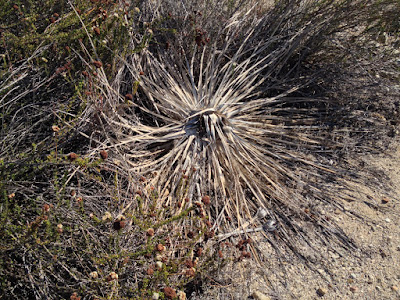Salad days. (Hesperoyucca whipplei.)
Saturday morning I set off on a mission to liberate a couple paddles of Cow's Tongue Prickly Pear (Opuntia engelmannii var. linguiformis), and check out some opuntias in the wash. There are two thickets of Cow's Tongue growing at the base of a slope below the Mousley Museum, and the museum's president of operations kindly told me to knock myself out (thanks, Claire!), so the expedition was on. I parked by the arroyo below the museum, and walked back up the road to the cactus.
How to get closer?
This approach looks risky.
This side looks better.
[takes out large knife, avoids eye contact with passing motorists]
Cow's Tongue is native to Texas and northern Mexico, and is now found all over the Southwest, because it's gorgeous. It also has the advantage of being frost hardy to at least -22F (according to this site. Beautiful cactus photos there...).
Wonderful big fruits, deep burgundy.
Mission accomplished! Two nice paddles sliced off and bagged. Next: find those opuntias in the wash. I know you're out there...
Chaparral, opuntia, two dried H. whipplei stalks like ivory tusks. Lizards were perfectly camouflaged until they darted. Rattlesnakes held their peace: too hot by now for much activity.
Deeper into the wash...
Cylindropuntia californica var. parkeri, valley/cane/snake cholla.
The big dirt nap.
What a beautiful little cactus!
There may be three species of opuntia growing here in the wash. Let's check Jepson. (California plant mavens can probably skip this next bit.)
"The Jepson eFlora is the foremost authority on the native and naturalized plants of California. For plants occurring in wildlands or otherwise outside of cultivation, the Jepson eFlora contains taxonomic treatments, distribution maps, illustrations, photographs, and identification keys."
Here in the wash we might have Opuntia littoralis, but the elevation is about 2700 feet and this area does get snow in the winter, so I'm leaning (carefully) toward frost-hardy Opuntia phaeacantha. And look at those spines on the cactus in the photo below -- yikes. Littoralis is extremely variable, but phaeacantha has the longest spines of the possible species, as far as I can tell. There may also be Opuntia ×vaseyi (O. littoralis × O. phaeacantha) growing here, but again... cold winters. I need to go back and take more photos, and in the meantime, phaeacantha gets my I-am-so-not-a-botanist vote.
This warmed my heart so much. The closest-to-home record of O. phaeacantha, according to the Jepson map, lists its locality as "Igo's Store, first canyon on the road to Barton Flats. San Bernardino Mt. Range." Small world! My great-grandparents spent summers up the road at Forest Home when their children were young, in the early 1900s, and I can't tell you how many times I heard older relatives speak of Igo's.
Opuntia phaeacantha, I think. Cochineal for sure.
"Note: Igo's Store is present location of Mountain Home Village, Hwy 38, San Bernardino Mtns., San Bernardino Co." added one S.D. White in 2006. The shades of my ancestors would like me to point out that Igo's was in fact on the other side of State Route 38. Eye-goes. Thank you, botanist Lyman Benson, for adding some sweet memories to the weekend cactus hunt!
































